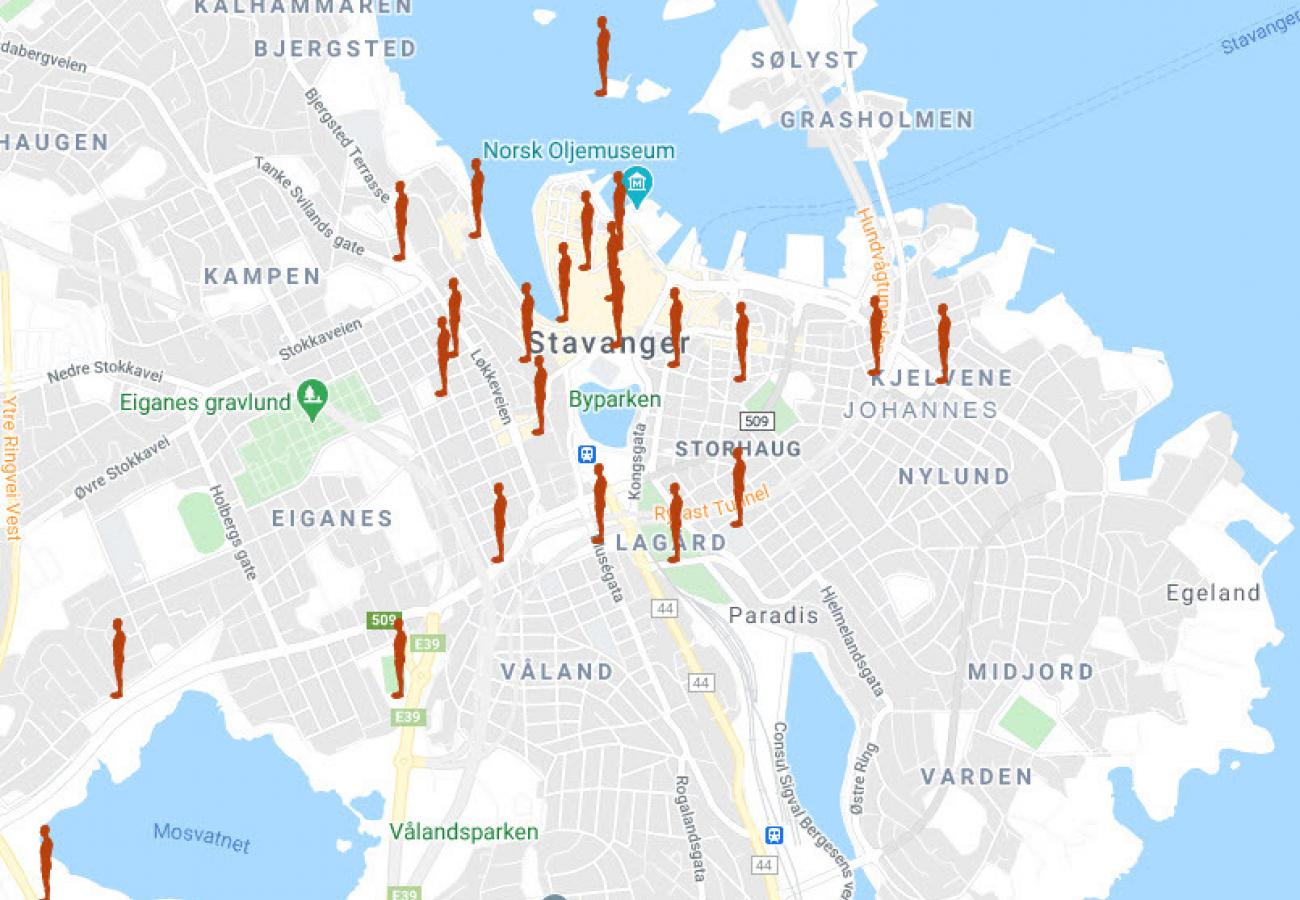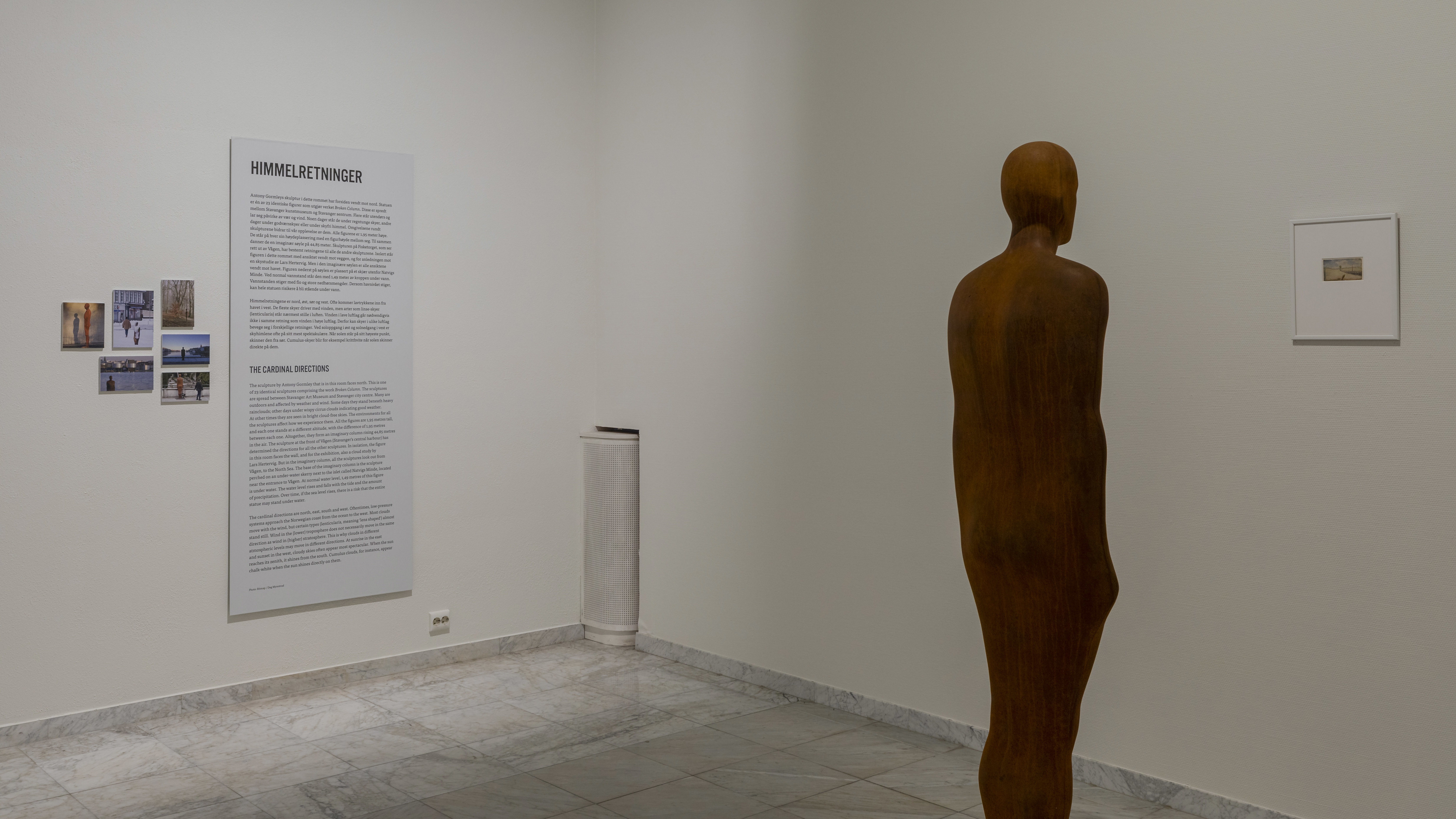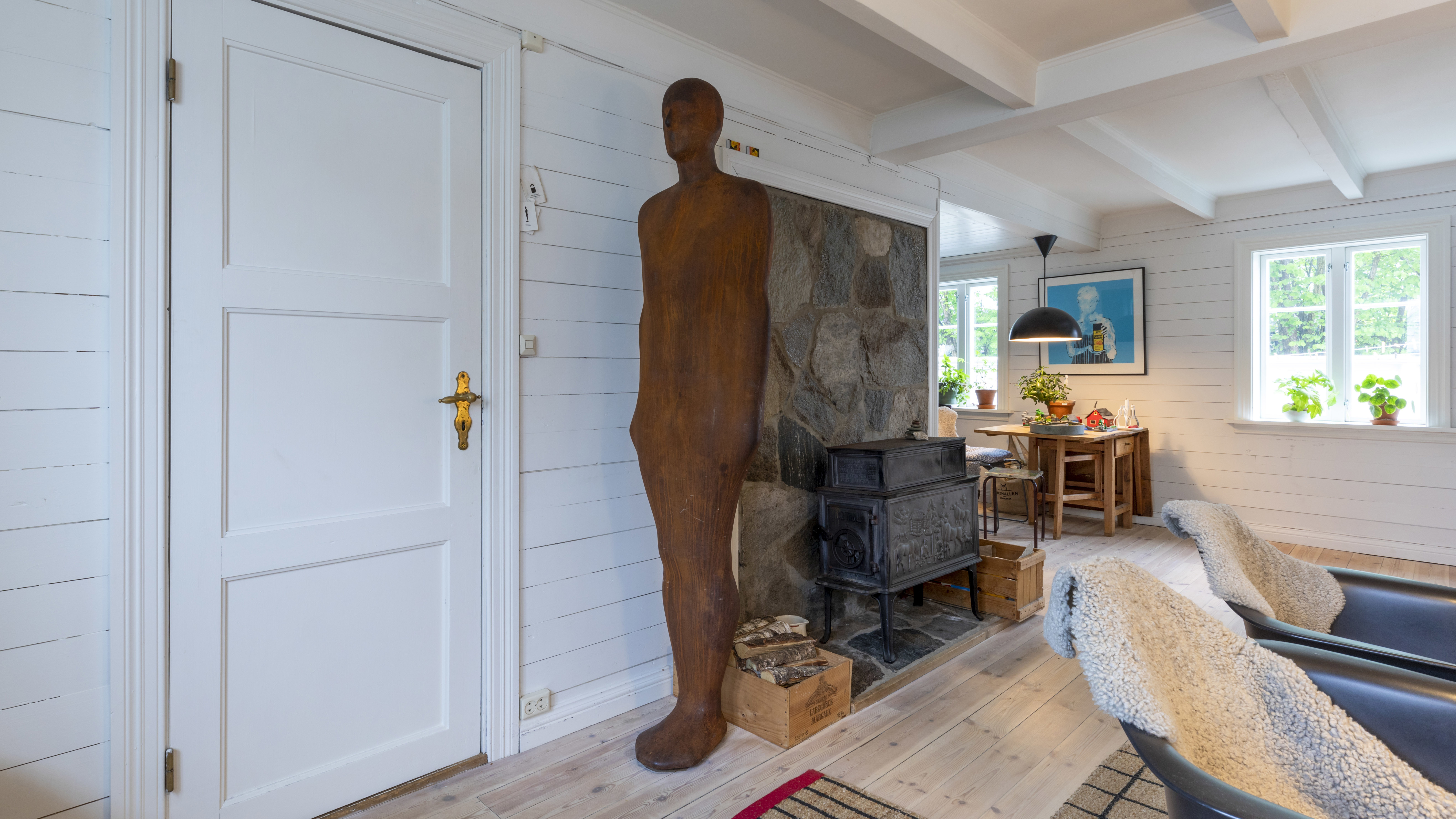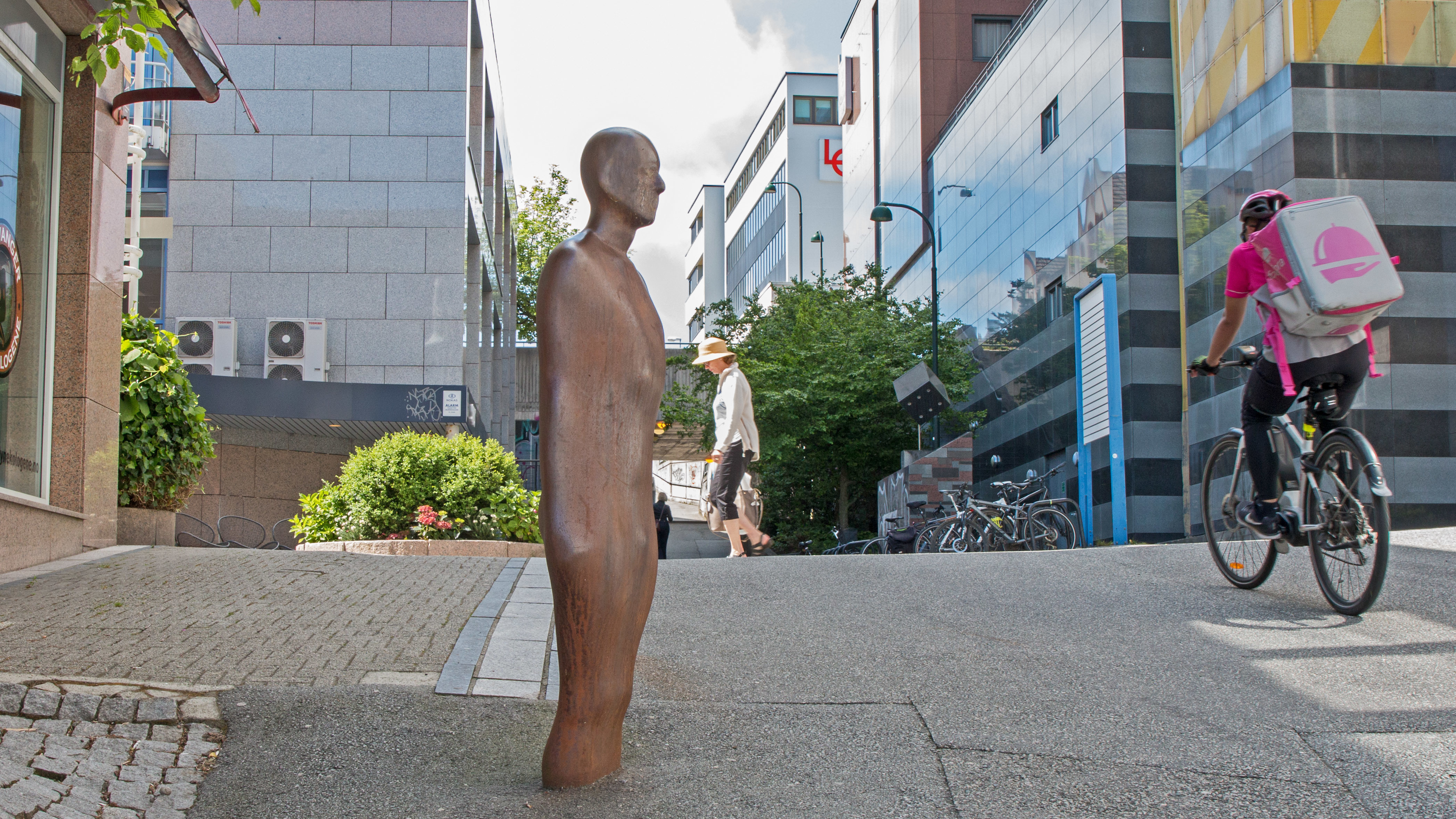


In this digital art hike we offer insight to Antony Gormley's site specific sculpture project 'Broken Column' (2003) which consists of 23 identical rusty steel sculptures mounted outdoors and indoors in public, semi-public and private places in Stavanger. The art project encourage us to explore and investigate the surroundings of Stavanger more closely. Every sculpture and place is marked on the map, companioned with photos and text. Have a nice city hike!
Broken Column by Antony Gormley (b. 1950) is Stavanger Art Museum’s largest work of art. It consists of 23 identical rusty steel sculptures mounted outdoors and indoors in public and private places in the city. The 1,95-metre-tall sculptures are based on a cast of the artist’s own body. They relate to each other through their elevation above or below sea level and through the direction in which they face. The sculpture at the fish market looks out from Vågen (Stavanger’s central harbour) and faces 10 degrees west of true north. It is this sculpture that determines the orientation of all the others. The idea is that all the sculptures look out to sea. Think of a topographical map with contour lines spaced at a difference in elevation of 1,95 metres each: all 23 sculptures stand on a different contour line, at a seemingly random point on their respective line. But if all the sculptures were in the exact same place, they would form one continuous column. At the top of this imaginary column is the sculpture inside Stavanger Art Museum. It stands in its own white gallery room, at 41,41 metres above sea level. The next sculpture is in Mosvann Park, on the Eiganes side, and it stands one body height lower, at 39,46 metres above sea level. At altitude-intervals of 1,95 metres, the placement of the statues continues down towards the city centre, to Vågen. The last sculpture stands just beyond the islet Natvigs Minde, at 1,49 metres below sea level. Here’s how the artist describes his idea: They are displaced vertebrae from an imagined column, the head of one connecting to the foot of the other.

Gormley asks: How can you make a work that becomes a way of looking again at a city rather than simply occupying it? His solution is to make numerous casts of his own body shape and to place the ‘clones’ here and there in the city in an interdependent order. Much of the centre of Stavanger is thus mapped on contour lines differentiated by 1,95 metres in altitude. This project is a conceptual work of art that analyses the city of Stavanger with the help of some topographical principles. Never is a sculpture’s placement random. There is a dynamic between the places, but since the sculptures are spread over a large area and stand in public, semi-public and private places, we do not, at first sight, understand the connection between them. We experience them piecemeal, just as we often experience urban spaces.

Broken Column is unlike traditional statues of famous men. The steel men, like silent witnesses, stand mostly on the same level as the city’s inhabitants. They have a connection to single-standing stones (menhir) from the Bronze Age. But it has been important for the artist that the sculptures have a shape we can empathise with, which reflects their openness to the contexts in which they are placed. The artist once talked about why he used his own body as the starting point for the sculptures: The most exact way in which I can experience the world is through my own body.

The artist thinks of the sculptures as ‘uninscribed objects’: … they don’t memorialise anyone in particular. Each one simply identifies a human space in space and shifts attention from the intrinsic qualities of the sculptures to the context that contains them.
Broken Column can be seen as an art project that quietly explores its surroundings. Through it, we are encouraged to explore and investigate our own surroundings more closely. What does Stavanger look like? What do we know about the city and its spaces? What does it feel like to be here? How do the urban spaces affect us both physically and mentally? What are the people who live here like?
Stavanger Art Museum is the official owner of the sculptural installation Broken Column, but it is to a very great extent owned by the people of Stavanger as a whole.
Antony Gormley, Broken Column, 1999–2003 (Sandblasted steel)
Gift from Christian Bjelland, Ådne Kverneland and Stavanger Municipality
Quotes
Antony Gormley's home page http://www.antonygormley.com/projects/item-view/id/251
Broken column (2004), Jan Inge Reilstad (red), Wigestrand forlag, Stavanger
Photos
Oddbjørn Erland Aarstad / May Johannessen
I denne digitale kartvandringen finner du informasjon om kunstprosjektet 'Broken Column', som består av 23 like rustne stålskulpturer plassert på ulike steder i Stavanger. Kunstneren Antony Gormley oppfordrer oss til å gå på oppdagelsesferd og undersøke Stavangers omgivelser nærmere. Hver skulptur og sted er avmerket på kartet, med bilder og tekst. God tur - fysisk eller digitalt!
Antony Gormleys (f.1950) Broken Column (Brutt søyle) er Stavanger kunstmuseums mest omfattende skulptur. Verket består av 23 identiske rustne stålskulpturer, som er plassert ute og inne, på offentlige og private steder i byen. De 1,95 meter høye skulpturene er basert på en avstøpning av kunstnerens egen kropp. De er forbundet med hverandre ut fra høyde over havet og himmelretning. Skulpturen på Fisketorget, som ser ut av Vågen, 10 grader vestover fra nord, bestemmer retningen til de andre skulpturene. Tanken er at alle skulpturene ser mot havet. Skulpturene står på bestemte koter slik at de til sammen danner en tenkt søyle. Øverst på søylen er skulpturen inne i Stavanger kunstmuseum. Den står i et eget hvitt gallerirom, som ligger 41,41 meter over havet. Den neste skulpturen befinner seg i Mosvannsparken på Eiganessiden, og den står én kroppshøyde lavere, det vil si 39,46 meter over havet. Med intervaller på 1,95 meter over havet fortsetter plasseringene ned mot sentrum, til Vågen og ut i sjøen til den aller siste skulpturen, som står med 1,49 meter under vann, rett utenfor et skjær ved Natvigs Minde. Kunstneren beskriver ideen slik: «De er fortrengte ryggvirvler fra en tenkt søyle, hvor hodet til den ene kobler seg til foten til den andre».

Hvordan skal man lage et verk som forholder seg til en by uten å «okkupere» den? Antony Gormleys løsning ble å støpe opp den samme enkle kroppsformen i et mangetall og plassere ‘kloningene’ rundt omkring i byen, i en innbyrdes orden. Store deler av Stavanger sentrum er dermed kartlagt i konturene på 1,95 meter. Slik er prosjektet et konseptuelt verk, som analyserer byen Stavanger ved hjelp av noen geologiske prinsipper. Plasseringene av skulpturene er ikke tilfeldig. Det finnes en dynamikk mellom stedene, men siden skulpturene er spredd over et større geografisk område og står på offentlige, semi-offentlige og private steder, får man ikke umiddelbart øye på sammenhengen mellom dem, man opplever dem bare stykkevis og delt, slik byrom også ofte oppleves i en by.

Broken Column skiller seg fra tradisjonelle statuer av berømte menn. Stålmennene står på bakken, som tause vitner, på samme nivå som menneskene i byen. De er beslektet med ‘standing stones’, bautasteiner eller lignende, men det var viktig for kunstneren at skulpturene antok en form som omgivelsene kan oppfatte med en slags medfølelse og som evner å motta omgivelsene den plasseres i. Kunsteren begrunner valget med å bruke sin egen kropp som utgangspunkt for skulpturene slik:
Den mest eksakte erfaringen av verden kan jeg bare gjøre gjennom min egen kropp.
Kunstneren tenker på skulpturene som ubeskrevne objekter, de står ikke der for å minne om noen spesielt; Hver og en identifiserer ganske enkelt et menneskelig rom i rommet og skifter oppmerksomhet fra skulpturenes iboende kvaliteter til konteksten som inneholder dem.
Broken Column er et kunstprosjekt som kan sees som en stille undersøkelse av sine omgivelser. Gjennom Broken Column oppfordes vi til å gå på oppdagelsesferd og undersøke våre omgivelser nærmere. Hvordan ser Stavanger ut? Hva vet vi om byen og rommene? Hvordan føles det å være her? Hvordan påvirker byrommene oss på et fysisk og mentalt plan? Hvordan er menneskene her?

Skulpturprosjektet tilhører Stavanger kunstmuseums samling og er en gave fra Christian Bjelland, Ådne Kverneland og Stavanger kommune.
Formidlingsprosjektet er et samarbeid mellom Stavanger kunstmuseum og Smartbyen Stavanger, støttet med midler fra Stavanger kommune.
Antony Gormley, Broken Column, 1999 – 2003 (Sandblåst stål)
Gave fra Christian Bjelland, Ådne Kverneland og Stavanger kommune
Sitater
Antony Gormleys hjemmeside
http://www.antonygormley.com/projects/item-view/id/251
Broken column (2004), Jan Inge Reilstad (red), Wigestrand forlag, Stavanger
Fotos
Oddbjørn Erland Aarstad / May Johannessen